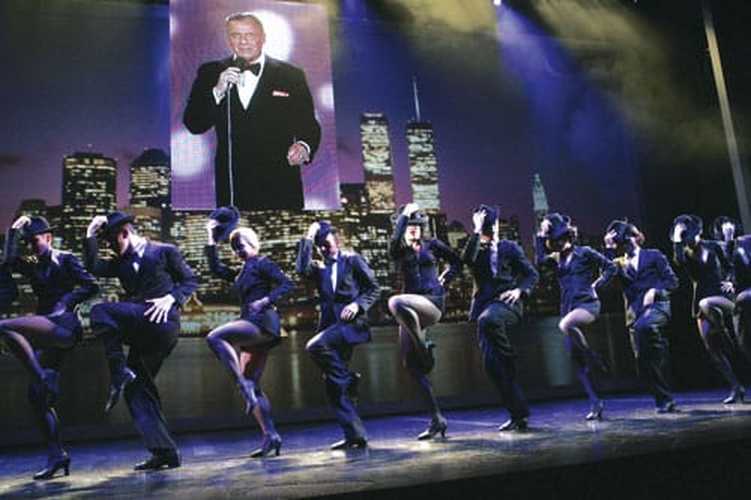VIRTUALLY FRANK
Autograph Sound designer Nick Lidster describes the show as the most challenging he has faced. Under David Leveaux' direction, the 'virtual' live season of Sinatra at the London Palladium, which opened in February, has been made possible by the discovery of vintage 35mm archive footage; this, and the consequent tape restoration and timecoding issues necessary to bring Frank Sinatra - larger than life - to nine moving video screens … synced to a 24-piece orchestra.
Autograph Sound are no strangers at providing even sound coverage around the London Palladium, with its 2,400-seat stalls and 'fanned' lower balcony and gallery circle areas, and reckon they have undertaken all the major shows in the theatre over the past ten years.
With a L,C,R line array hang (and 54 distributed Martin Audio Effect 3R cinema speakers) the audio is run in 5.1 surround sound, with two suspended five-box Martin W8LC's taking care of the two near flanks and the vocals coming as a mono signal through the centre cluster. Autograph have used the custom frame they designed for Miss Saigon to fly the Martin WSX subs above the W8LCs. 'They screw into the dolly boards and ensure we can rig them on trusses,' explains Lidster. 'We have one WSX each side in the air and another each side on the ground.'
He explains that with a show such as this - a live swing band (including seven-piece string section) and 16 dancers reinforcing Ol' Blue Eyes' voice 'you don't need gut-churning power. It's a balance of all the disciplines,' states the designer.
A further six W8LC's are ground-stacked each side of the stage (along with the WSX) and there are strategically-placed delays and front fills. Spread throughout the different levels are the Effect 3R's, which are increasingly finding favour for reproducing surround effects on West End musicals.
Nick Lidster is now on his third outing with a Martin Audio line array system, after first auditioning it at Brixton Academy and then demoing a system on Les Miserables in Berlin. Says colleague Scott Arnold, 'Nick always wanted to use the Martin system here, knowing he would need power as well as quality. You don't have a 24-piece orchestra and expect the show to run quietly - it's not going to happen.'
'This is a good sounding room but there are difficult areas,' acknowledges the sound designer. 'As the Martin Audio W8LC is fully horn-loaded we have been able to 'steer' the audio accurately into the different areas; this is not the case with some systems where you get a huge low-end build-up which you cannot get rid of.
'That has been the big advantage on this show - the fact that because the Martin system is horn-loaded you have a much greater control of the low-end while the HF projects and shines like a torch, and has been very impressive. At the back of the circle the sound is bright, clean and crisp, with no delays upstairs whatever. It means I can turn up the HF without killing people downstairs near the stage. And unlike other line arrays, when you walk off axis the W8LC is fairly smooth and everything rolls off evenly without sounding muddy.'
Nick Lidster (inset pic) has used ViewPoint™ as the foundation of his design – fine adjusting angles to fit the venue. He has also used Martin Audio's crossover presets, feeding these into the new XTA 428, via the latest AudioCore software. 'However, because we were trying to go for a more naturalistic sound we didn't need the LF lift that might be used if we were running a rock 'n' roll show.'
Outboard processing used includes a TC Electronic S6000 reverb, Drawmer compression and gates and some valve compression on Sinatra's voice.
With most of their inventory out on Mamma Mia in Madrid, Autograph Sound purchased 18 addition W8LC's for a show they believe they were awarded in view of its sheer complexity. 'It has been a case of making the sound and video work in conjunction with each other,' declares Nick. To do this they used Pro Tools HD; the original material is triggered by MIDI from a Cadac G-Type, operated by Paul Stannering, and will end up on Tascam playback.
'We are using two Pro Tools HD systems for Sinatra's voice and the sound effects and Pro Tools runs the timecode that drives the projection,' the designer continues. 'Rob Tory, our Pro Tools engineer, has done all the click tracks which go to the MD on headphones, the audio is ethernetted back to the company office where the other Pro Tools HD system resides.'
But the show itself is a triuimph for putting Frank Sinatra's voice in front of a live orchestra.
An audio pioneer in his own right, Sinatra had done a lot of archiving, pre-recording some of his early (1957-58) TV series in stereo and using 35mm film. This was digitised and rotoscoped, with the images removed. Because the recordings featured discrete audio tracks and relatively sparse instrumentation, the immediate bonus was that the vocals could be extracted and the new live orchestrations mixed in.
The recordings were processed at Autograph using the CEDAR Cambridge v2.6 restoration system to remove all the extraneous noise and hiss.
Using CEDAR NR-4 Advanced Noise Reduction, Auto Dehiss, and Debuzz - Buzz and Hum Removal, CEDAR's in-house restoration engineer, Paul Alexander removed general background noise as well as unwanted hiss and buzz. He explained,'The original recordings and transfers were of extremely high quality and most of the background noise that I removed was due to problems with the initial recording in the 1950s.'
Ultimately it has been the reconciliation of the old and new, perfectly synchronised, with which Autograph have been tasked.
Small wonder then that Nick Lidster has had sleepless nights worrying about this show. 'Because of the level of technology used you do feel very responsible,' he says. e
